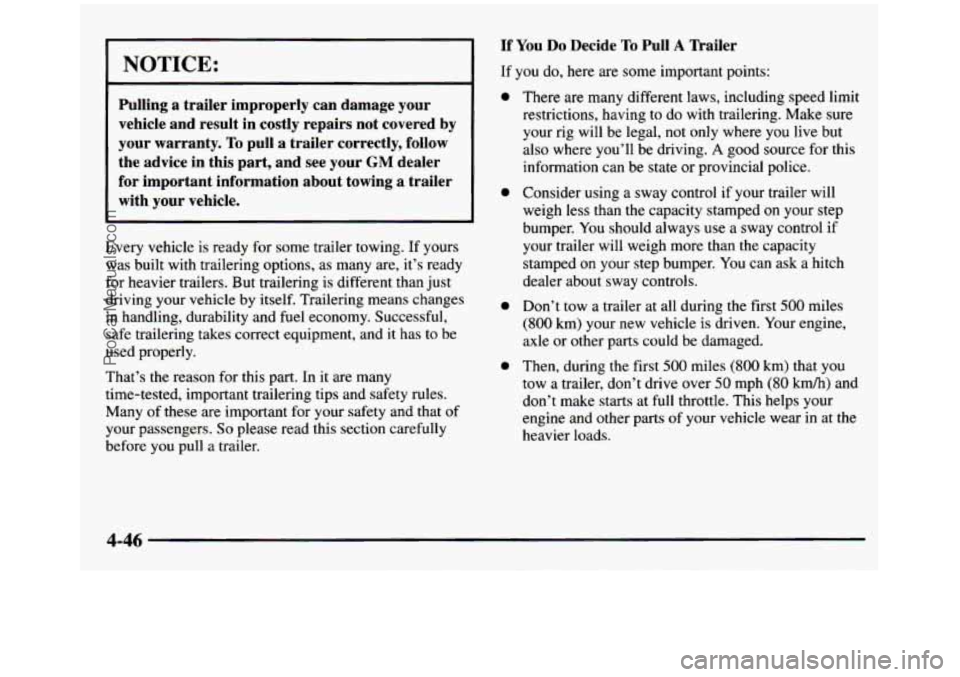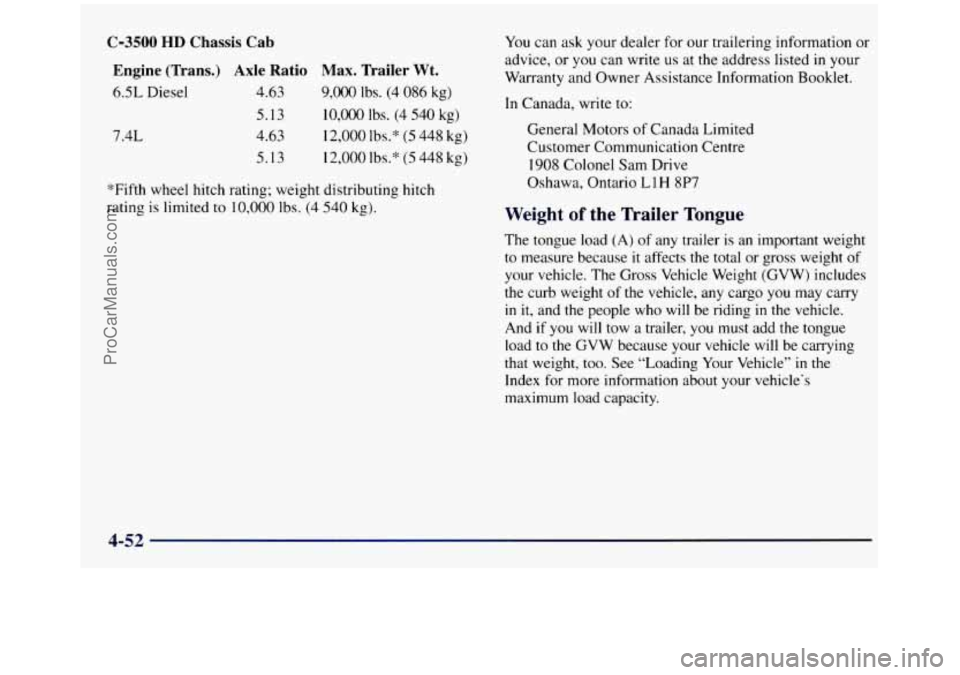Page 218 of 436

- -
A CAJTldN:
Snow can trap exhaust gases under your vehicle.
This can cause deadly
CO (carbon monoxide) gas
to get inside.
CO could overcome you and kill
you. You can’t see it or smell it,
so you might not
know
it is in your vehicle. Clear away snow from
around the base of your vehicle, especially
any
that is blocking your exhaust pipe. And check
around again from time to time to be sure snow
doesn’t collect there.
Open
a window just a little on the side of the
vehicle that’s away from the wind. This will help
keep
CO out. Run your engine
only as long as you must. This saves
fuel. When you run the engine, make
it go a little faster
than just idle. That is, push the accelerator slightly.
This uses less fuel for the heat that you get and
it
keeps the battery (or batteries) charged. You will need a
well-charged battery (or batteries) to restart
the vehicle,
and possibly for signaling later on with your headlamps.
Let the heater run for awhile.
If you have
a diesel engine, you may have to run it at a
higher speed to get enough heat. Then, shut the engine
off and close the window almost all the way to preserve
the heat. Start
the engine again and repeat this only
when
you feel really uncomfortable from the cold. But
do it as little as possible. Preserve the fuel as long as
you
can. To help keep warm, you can get out of the vehicle
and do some fairly vigorous exercises every half hour
or
so until help comes.
4-40
ProCarManuals.com
Page 224 of 436

NOTICE:
Pulling a trailer improperly can damage your
vehicle and result in costly repairs not covered
by
your warranty. To pull a trailer correctly, follow
the advice in this part, and see your
GM dealer
for important information about towing a trailer with
your vehicle.
Every vehicle is ready for some trailer towing. If yours
was built with trailering options, as many are, it’s ready
for heavier trailers. But trailering is different than just
driving your vehicle by itself. Trailering means changes
in handling, durability and fuel economy. Successful,
safe trailering takes correct equipment, and it has
to be
used properly.
That’s the reason for this part. In it are many
time-tested, important trailering tips and safety rules.
Many
of these are important for your safety and that of
your passengers.
So please read this section carefully
before
you pull a trailer.
If You Do Decide To Pull A Trailer
If you do, here are some important points:
0
0
0
0
There are many different laws, including speed limit
restrictions, having
to do with trailering. Make sure
your
rig will be legal, not only where you live but
also where you’ll be driving.
A good source for this
information can be state
or provincial police.
Consider using
a sway control if your trailer will
weigh less than the capacity stamped on your step
bumper.
You should always use a sway control if
your trailer will weigh more than the capacity
stamped on your step bumper. You can ask
a hitch
dealer about sway controls.
Don’t tow a trailer at all during the first
500 miles
(800 km) your new vehicle is driven. Your engine,
axle or other parts could be damaged.
Then, during the first
500 miles (800 km) that you
tow a trailer, don’t drive over 50 mph (80 kmh) and
don’t make starts at full throttle. This helps your
engine and other parts of your vehicle wear in at the
heavier loads.
4-46
ProCarManuals.com
Page 225 of 436

a If you have an automatic transmission, you can tow
in OVERDRIVE (@). You may want to shift the
transmission to THIRD
(3) or, if necessary, a lower
gear selection if the transmission shifts too often
(e.g., under heavy loads and/or hilly conditions). If
you have a manual transmission and you are towing
a trailer, it’s better not to use FIFTH (5) gear. Just
drive in
FOURTH (4) gear (or, as you need to,
a lower gear).
Three important considerations have to do with weight:
the weight of the trailer,
the weight of the trailer tongue
and the weight on your vehicle’s tires.
Weight of the Trailer
How heavy can a trailer safely be?
It depends on how you plan to use your rig. For example,
speed, altitude, road grades, outside temperature and
how much your vehicle is used to pull a trailer are all
important. And, it can also depend
on any special
equipment that you have on your vehicle. Use
one of the following charts to determine how much
your vehicle can weigh, based upon your vehicle model
and options.
Maximum trailer weight is calculated assuming the
driver and one passenger are in the tow vehicle and it
has all
the required trailering equipment. The weight of
additional optional equipment, passengers and cargo in
the tow vehicle must be subtracted from the maximum
trailer weight.
Above the
2,000 lbs. (908 kg) trailer rating, the engine
oil cooler is required
on C/K-1500 and C/K-2500
models with gas engines. Refer to the Trailering Guide
for oil cooler recommendations.
Above the
5,000 lbs. (2 270 kg) trailer rating, heavy-duty
or gas shock absorbers are required on
C- 1500 models,
and heavy-duty shock absorbers or the off-road chassis
package are required on
K- 1500 models.
4-47
ProCarManuals.com
Page 226 of 436
4.3L (Manual) 5.0L
(Auto.)
5.0L (Manual)
5.7L
6.5L Diesel
C-1500 (2WD)
Engine (Trans.) Axle Ratio
4.3L (Auto.) 3 .OS
3.42
3.73
3.08
3.42
3.73
3 .OS
3.42
3.08
3.42 3.08
3.42
3.73
3.08
3.42
Max. Trailer Wt.
4,000 lbs. (1 800 kg)
5,000 lbs. (2 270 kg)
5,500 lbs. (2 497 kg)
2,000 lbs. (908 kg)
2,500 lbs.
(1 135 kg)
3,000 lbs.
(1 362 kg)
4,500 lbs. (2 043 kg)
5,500 lbs. (2 497 kg)
2,000 lbs. (908 kg)
3,000 lbs.
(1 362 kg)
5,000 lbs. (2 270 kg)
6,000
lbs. (2 724 kg)
7,000 lbs. (3 178
kg)
6,000 lbs. (2 724 kg)
7,000 lbs. (3 178 kg)
K-1500 (4WD)
Engine (Trans.)
4.3L (Auto.)
4.3L (Manual)
5.0L (Auto.)
5.0L (Manual)
5.7L
6.5L Diesel
Axle Ratio
3.73
3.73
3.42
3.73
3.42
3.73
3.42
3.73
3.42
3.73
Max. Trailer Wt.
5,000 lbs. (2 270 kg)
2,500
lbs. (1 135 kg)
5,000 lbs. (2 270 kg)
6,000 lbs. (2 724 kg)
2,500 lbs.
(1 135 kg)
3,500
lbs. (1 589 kg)
5,500 lbs. (2 497 kg)
6,500 lbs. (2 95 1 kg)
6,000 lbs. (2 724 kg)
7,000
lbs. (3 178 kg)
4-48
ProCarManuals.com
Page 227 of 436

C-2500 (2WD) K-2500 (4WD)
5 .OL (Manual)
5.7L
Engine (Trans.) Axle Ratio Max. Trailer Wt.
5.0L (Auto.) 3.42 5,500 lbs. (2 497 kg)
3.42 3,000 lbs.
(1 362 kg)
3.42 6,000 lbs. (2 724 kg)
4.10
8,000 lbs. (3 632 kg)
6.5L Diesel 3.42 6,500 lbs. (2 951 kg)
(Auto.) 3.73
7,500 lbs. (3 405 kg)
4.10 8,500 lbs. (3 859 kg)
7.4L (Auto.) 3.73 9,000 lbs.* (4 086 kg)
4.10
1 I ,OOO lbs.** (4 994 kg)
3.73 6,500
lbs.
(2 95 1 kg)
3.73
4,000 lbs. (1 800 kg)
3.73 7,000 lbs.
(3 178 kg)
*Fifth wheel hitch rating; weight distributing hitch
rating is limited to 9,000 lbs. (4 086 kg).
**Fifth wheel hitch rating; weight distributing hitch
rating is limited to 10,000 lbs. (4 540 kg). 6.5L Diesel
Engine (Trans.) Axle Ratio Max. Trailer Wt.
5.7L
3.73 6,000 lbs. (2 724 kg)
4.10 7,500 lbs. (3 405 kg)
3.42 6,000 lbs. (2 724 kg)
4.10 8,000 lbs. (3 632 kg)
7.4L (Auto.) 3.73
8,500 lbs.* (3 859 kg)
4.10 10,500 lbs.** (4 767 kg)
*Fifth wheel hitch rating; weight distributing hitch
rating is limited to
8,500 lbs. (3 859 kg).
**Fifth wheel hitch rating; weight distributing hitch
rating is limited to 10,000 lbs. (4 540 kg).
3.73
6,500 lbs.
(2 951 kg)
4-49
--
ProCarManuals.com
Page 228 of 436
C-3500 (2WD) K-3500 (4WD)
6.5L Diesel
7.4L
Engine (Trans.) Axle Ratio Max. Trailer Wt.
5.7L 4.10 7,500 lbs. (3 405 kg)
4.10
8,000 lbs. (3 632 kg)
4.56
9,000 lbs. (4 086 kg)
4.10 10,500 lbs.* (4 767 kg)
4.56 12,500 lbs.*
(5 675 kg)
*Fifth wheel hitch rating; weight distributing hitch
rating is limited to
10,000 Ibs. (4 540 kg).
Engine(Trans.) Axle Ratio Max. Trailer Wt.
5.7L 4.10 7,000 lbs. (3 178 kg)
6.5L Diesel 4.10 7,500 lbs. (3 405 kg)
7.4L 4.10 10,000 lbs. (4 540 kg)
4.56 12,000 lbs.* (5 448 kg)
*Fifth wheel hitch rating; weight distributing hitch
rating is limited to
10,000 lbs. (4 540 kg).
4-50
ProCarManuals.com
Page 229 of 436
C-3500 Crew Cab (2WD)
6.5L Diesel
7.4L
Engine (Trans.) Axle Ratio Max. Trailer Wt.
5.7L 4.10 7,000 lbs. (3 178 kg)
4.56 8,500 lbs.
(3 859 kg)
4.10 8,000 lbs.
(3 632 kg)
4.10 10,500 lbs.* (4 767 kg)
4.56 12,500 lbs.*
(5 675 kg)
*Fifth wheel hitch rating; weight distributing hitch
rating is limited to
10,000 lbs. (4 540 kg).
K-3500 Crew Cab (4WD)
6.5L Diesel
7.4L
Engine (Trans.) Axle Ratio Max. Trailer Wt.
5.7L 4.10 6,500 lbs. (2 951 kg)
4.56
8,000 lbs. (3 632 kg)
4.10 7,500 lbs.
(3 405 kg)
4.10 10,000 lbs.* (4 540 kg)
4.56 12,000 Ibs.*
(5 448 kg)
*Fifth wheel hitch rating; weight distributing hitch
rating is limited to 10,000 lbs. (4
540 kg).
4-51
ProCarManuals.com
Page 230 of 436

C-3500 HD Chassis Cab
Engine (Trans.) Axle Ratio
Max. Trailer
Wt.
6.5L Diesel 4.63 9,000 lbs. (4 086 kg)
5.13 10,000 lbs. (4 540 kg)
4.63 12,000 lbs.*
(5 448 kg)
5.13
12,000 lbs.* (5 448 kg)
7.4L
*Fifth wheel hitch rating; weight distributing hitch
rating is limited to
10,000 lbs. (4 540 kg). You
can ask your dealer for our trailering information or
advice, or you can write us at the address listed in your
Warranty and Owner Assistance Information Booklet.
In Canada, write to:
General Motors of Canada Limited
Customer Communication Centre 1908 Colonel Sam Drive
Oshawa, Ontario L1H 8P7
Weight of the Trailer Tongue
The tongue load (A) of any trailer is an important weight
to measure because it affects
the total or gross weight of
your vehicle. The Gross Vehicle Weight (GVW) includes
the curb weight
of the vehicle, any cargo you may carry
in it, and the people who will be riding in the vehicle.
And
if you will tow a trailer, you must add the tongue
load to the GVW because your vehicle will be carrying
that weight, too.
See “Loading Your Vehicle” in the
Index for more information about your vehicle‘s
maximum load capacity.
4-52
ProCarManuals.com